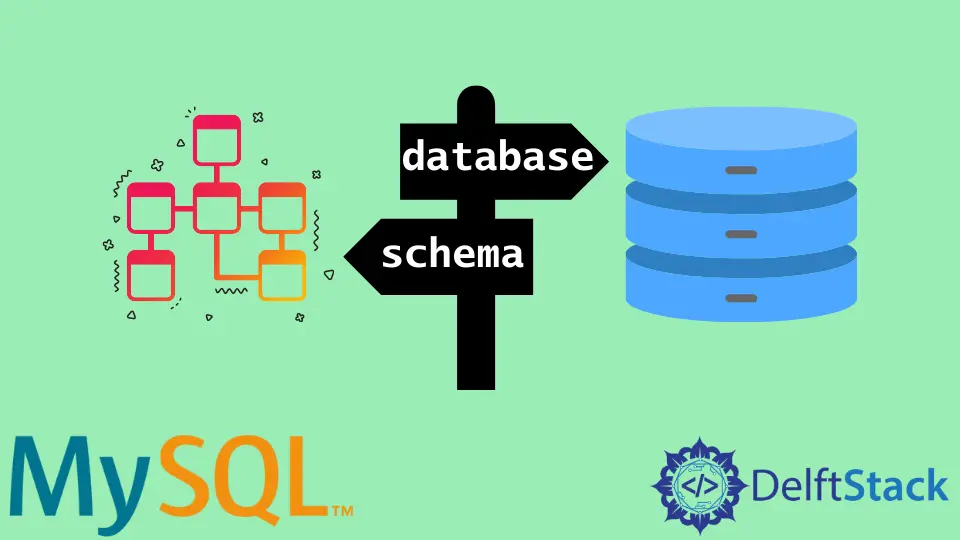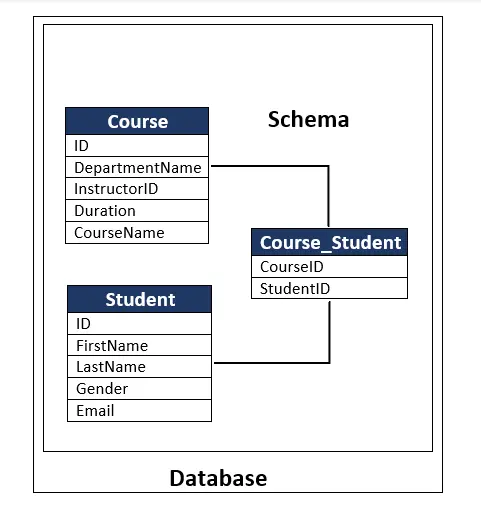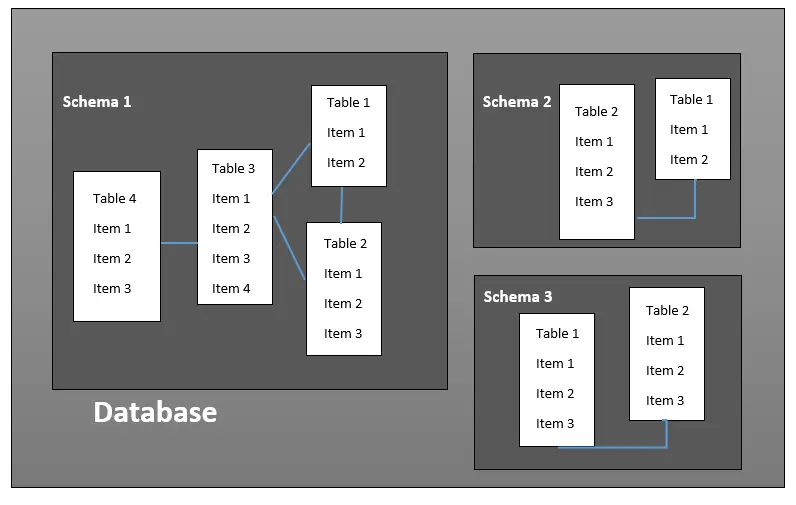Difference Between Schema and Database in MySQL
- Database in MySQL
- Schema in MySQL
- MySQL Schema vs Database
- Key Differences Between Schema and Database
-
MySQL
SCHEMAvsDATABASE -
Oracle
SCHEMAvsDATABASE - Conclusion

In the world of MySQL, understanding the distinction between a schema and a database is crucial for effective database management. While these terms are often used interchangeably, they represent different entities within the MySQL ecosystem.
This article will delve into the details of schemas and databases, providing a comprehensive understanding of their roles, differences, and how they contribute to organizing and managing data.
Schema and database are the two most important terms in Database Management Systems (DBMS). Every organization, school, college, and institute has its own database.
They used it to manage their data and retrieve it in an organized manner. Before creating the database, one has to design and finalize its schema where all the entities, attributes, and the relationships.
Here, entities mean tables and attributes mean column names. The relationship among entities/tables can be one-to-one, one-to-many, or many-to-many to reduce redundancy.
Once the schema is finalized, it is good to go and create a database. It is because the database keeps updating, but the schema is not updated very often without any good reason.
Otherwise, the whole organization’s data will be disturbed.
Database in MySQL
A MySQL database is a structured collection of data that is organized and stored for easy retrieval. It serves as a container for tables, indexes, views, and other database objects.
Databases are essential for categorizing and managing data efficiently, and they play a fundamental role in database management systems (DBMS).
The collection of organized and interrelated data is known as a database. There are various applications to store data in a database, including MySQL, Microsoft SQL, Oracle, etc.
Every database differs because every company/organization has its structure, data types, and constraints. A database is regularly updated to have updated data about the company.
A database can be maintained manually and digitally. In this era, where data is everywhere, digital database is preferred and used.
The size of the database depends on the organization’s data and needs.
Characteristics
- Container for Data: A database acts as a container that holds tables, views, stored procedures, and other objects.
- Separation of Concerns: Each database is independent of others, ensuring a clear separation of concerns and allowing for better organization and maintenance of data.
- Access Control: MySQL provides access control at the database level, allowing administrators to manage permissions for users at this level.
Example:
CREATE DATABASE sample_database;
In this example, a new MySQL database named "sample_database" is created.
Schema in MySQL
A MySQL schema is a namespace or container within a database that is used to organize and manage database objects. Schemas provide a way to group database objects, such as tables and views, into a logical structure.
In MySQL, the terms database and schema are often used interchangeably, but it’s essential to recognize the subtle difference.
Schema is the logical representation that describes the structural definition or description of a whole database. A schema cannot be changed very often; that is why one must be very careful while designing it.
If it keeps on changing very often, it will disturb the company’s data in the database. How? See the following screenshot:

We took a small part of a college schema in the above screenshot. In the above schema, you can see what entities are included, what attributes they can have, and how they will be associated with each other.
You may have noticed that the schema is presented in diagram form; it is called a schema diagram. A schema does not show all the aspects of the database, for example, instances of the database.
Characteristics
- Logical Organization: Schemas provide a logical organization of database objects within a database.
- Object Grouping: Objects like tables, views, and stored procedures can be grouped within a schema, making it easier to manage and understand the database structure.
- User Context: In MySQL, a schema is closely associated with the user context. Each user has a default schema, and any objects created by the user belong to that schema.
Example:
CREATE SCHEMA sample_schema;
In this example, a new MySQL schema named "sample_schema" is created.
MySQL Schema vs Database
- The basic difference between a database and a schema is that the database is manipulated regularly while the schema is not changed frequently.
- The schema is the structural definition of the database, while the database is the collection of organized and interrelated data.
- Database has the schema and records for the tables, but schema includes tables, attribute names, attribute types, constraints, etc.
- DDL (Data Definition Language) statement is used to generate and modify the schema, while DML (Data Manipulation Language) is used for data manipulation in the database.
- Schema does not use memory for storage purposes, but the database does.
Key Differences Between Schema and Database
1. Scope and Purpose
- Database: Represents the entire collection of data, providing a container for multiple schemas, tables, and other objects.
- Schema: Represents a logical grouping within a database, organizing tables and other objects.
2. Independence
- Database: Operates independently, allowing for clear separation and organization of data at a higher level.
- Schema: Exists within a database and provides logical organization but doesn’t operate independently. It is a part of the overall database structure.
3. User Context
- Database: Access control is at the database level, and each database may have its own set of users and permissions.
- Schema: Associated with the user context, and each user has a default schema. Objects created by a user belong to their default schema.
4. SQL Statements
- Database: SQL statements like
CREATE DATABASEandUSEare used to create and switch between databases. - Schema: SQL statements like
CREATE SCHEMAandUSEare used to create and set the default schema.
MySQL SCHEMA vs DATABASE
In MySQL, database and schema can be used interchangeably. You can use SCHEMA instead of DATABASE and vice versa while writing SQL queries in MySQL.
Oracle SCHEMA vs DATABASE
According to Oracle and other enterprise-level database solutions, schema is a collection of tables, and a database is a collection of schema. See the following diagram:

Conclusion
In the MySQL ecosystem, databases and schemas are integral components for organizing and managing data. While the terms are sometimes used interchangeably, it’s essential to recognize the nuanced differences between them.
A MySQL database serves as a broad container for data, providing separation and independence. On the other hand, a schema is a logical grouping within a database, allowing for a more granular organization of tables and objects.
Understanding the roles and distinctions between databases and schemas is crucial for designing efficient and maintainable database structures in MySQL. By leveraging these concepts effectively, database administrators and developers can create robust and scalable systems that meet the needs of their applications.
